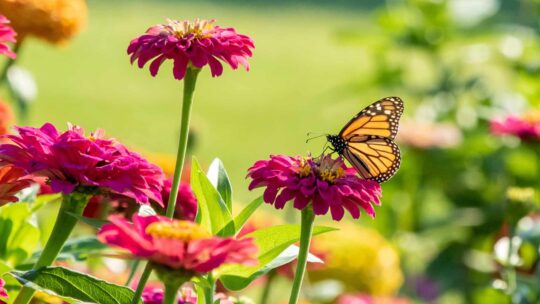Summer is the best time to enjoy your backyard—but how do you enjoy it without nuisance biting insects ruining the fun? Join environmental biologist and Exmark Ambassador Grae Buck as he takes you through important steps and processes to remember for effective mosquito control in ponds and in your backyard.
Both aesthetically pleasing and beneficial for birds and pollinators, ponds and water features are wonderful amenities in your backyard. However, standing water is a prime mosquito habitat. Mosquitos, while annoyingly pesky, also carry disease such as West Nile Virus, so preventing reproduction in your backyard is vitally important.
Eliminate the breeding habitat by addressing the source directly. Mosquitos require standing or slow moving water to breed and cannot reproduce in flowing water. From egg to adult, the mosquito life cycle takes four to fourteen days—the first several require stagnant water, so eliminating those sources on your property will drastically reduce breeding capability.
Ways to Prevent Mosquito Breeding
- Routinely clean roof gutters and downspouts, as clogged gutters or downspouts provide a haven for mosquito breeding. Ensure that drainage swales are free of debris and flowing properly to direct water away from your house.
- Cover or remove anything that collects and holds water, such as old tires, tarps, boats, trash cans, rain barrels and buckets, small pools, or playground equipment. Drill holes in tire swings to allow drainage.
- Drain, clean, and refill your bird baths at least twice a week.
- Routinely empty plant saucers and drill holes in plant pots to allow them to properly drain.
- Routinely mow and manage backyard vegetation to ensure drainage.
- Drain kiddie pools when not in use, and properly maintain and chlorinate swimming pools.
- Support predator species. Bats provide excellent natural control of mosquitos, and you can help support their populations by providing a bat house or shelter, a water source, and supporting night-pollinating insects through planting of native flowering species.

Mosquito Control for Ponds
To reduce mosquito breeding in backyard ponds:
- Keep the water moving. Add an electric aeration system, bubbler, or fountain to circulate the water. Aeration benefits fish and aquatic plants—and reduces odor, as an added benefit.
- Manage algae on which mosquito larvae feed. Mechanical removal or use of algaecides will control the organic matter that grows algae and feeds mosquitos. Aeration will also help to reduce algal growth.
- Introduce natural control! Support the critters which feed on mosquitos and larvae. If your pond or water feature supports fish, consider introducing minnows that feed on mosquito larvae. Consult with a local pond store or resources to determine which native minnow will survive in your backyard pond without threatening other native species. Tadpoles and frogs are also excellent predators to control mosquito populations. However, fish eat frog eggs, so it is important to manage your fish populations and select appropriate species in order to support diverse aquatic life. Support frog habitat in your pond with aquatic vegetation, rocks, and other natural items which provide cool, shady habitat and water access. Protection from predators such as herons is important, too.
- Implement a larvicide mosquito dunk. This biological form of pest control utilizes bacteria to control larvae immediately, for up to 30 days, and is safe around people and pets. It only harms larvae so it will not affect natural predators or other aquatic life. If using other chemical controls, ensure they are safe for aquatic life and vegetation.
That’s it! Now you’ve got the knowledge you need to get out there and combat the world’s most annoying pest.



